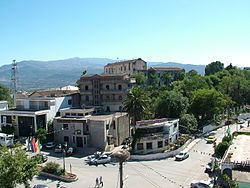Country Algeria Area 232.1 km² | Time zone CET (UTC+1) Population 80,000 (2009) | |
 | ||
El milia jijel mouad moures
El Milia ( الميلية) is a town and commune in Jijel Province, Algeria. According to the 2009 census it has a population of 80,000.
Contents
- El milia jijel mouad moures
- Map of El Milia Algeria
- Alg rie el milia premi re partie
- Geography
- Climate
- Population
- History
- The Commune of El Milia
- Bishopric
- References
Map of El Milia, Algeria
The town of El Milia is located in north-eastern Algeria, in Constantinois. It is located halfway between the cities of Jijel, Mila, and Constantine and Skikda. The Mediterranean Sea is about twenty kilometers north of the town. The territory of the municipality of El Milia is located northeast of the province of Jijel. It is the largest city area of the region.
Alg rie el milia premi re partie
Geography
The region of El Milia is characterized by a very rugged mountainous terrain, mountains occupy 82% of the total area, they peak at 1200 m. Characterized by a pristine coastline and small mountains covered by dense enough vegetation and water sources.
Climate
The climate of the El Milia region is a Mediterranean climate characterized by warm summers and mild winters but is very humid. In summer the temperature reache 40c° and 0c° in winter.
Population
The family name used to refer to the Arabic-speaking highlanders in the region of El Milia was Kabyle hadra. The ethnic origin of these is that the first inhabitants of the region were the Kutama,. In the 11th century, following the overthrow of the Fatimid empire and fall of Kutamas, a settlement was founded by various Berber tribes (especially Sanhadja) who came from other cities and regions of Algeria in particular highland but also Morocco and moved to El Milia and its surroundings, they never mixed with Hilali Arab tribes, and later Muslims refugees from Andalusia expelled from Spain. There is also more recently a small Ottoman influx.
Among the tribes that are in the city of El Milia and the region, regardless of origin, are: Ouled Aidoun, Fergane Beni, Beni Belaid, Beni meslim, Tileman, Feteh Beni, Beni Aicha, Beni Khettab, Ouled Ali Ouled Aouat, Ouled Boufaha, Mechat El Achache, Beni Caid, Ouled Mbareek, Telilane Beni, Beni Sbih.
History
Home to many battles against French colonists, the region is one of the pillars of the war of independence and the fight against French colonial army.
The city has long been a set of small mechtas dispersed until 1860 when a small village was built linking the French colonization, under the direction of the department of Constantine, in order to submit the tribe of Ouled Aidoun. Under the French occupation the area was part of Kabylia East.
Since the installation in the city of El Milia, the borj in 1860 by the French, who helps manage Ouled Aidoun these last humiliated and ruined face the submission of taxes and the exploitation of their riches, decided at the end of a meeting, to attack the next day at dawn the El Milia camp and take control of the French military tower. This revolt of February 14, 1871 will mark the beginning of the general armed uprising in the eastern Kabylie.
The uprising that took place in two phases lasted about 9 months, pending which the camp of reserve soldiers was destroyed, and the beleaguered military tower in over a week. The occupation forces then mobilized some 10,000 soldiers to try to quell the uprising and the El Mokrani, the French soldiers with superiority in armaments managed to get the upper face an enemy lacking any. In retaliation against the population, the occupier thereof subject to additional taxes, confiscated land and suppressed people by the arrest and deport. The region of El Milia then entered a period darker history.
During the war in Algeria, the tribes of the region of El Milia, then part of the historic wilaya II of North Constantine, played a large role in the fight against the settlers, particularly in the attacks of 20 August 1955 that will remain forever etched in the annals of war indépendance.
The subjugation of the region was not easy and we did not succeed after successive campaigns. The most important took place in 1847, 1850, 1851, 1852, 1853, 1858, 1860, 1861 and 1865 and were led by generals.
It was in August 20, 1955 and the days that followed the fighting has been the fiercest, which subject the French colonial troops in huge losses. This impelled to declare Zighoud Youcef "If we lost militarily and politically won in north-eastern Constantine, that is to say in Skikda and its periphery, I can tell you that we won militarily and politically in the northwest of Constantine, particularly in El Milia. "
The Commune of El Milia
The municipality of El Milia is composed of one hundred and one localités, villages and hamlets.
Bishopric
The Diocese of Mulia is a suppressed and titular see of the Catholic Church in the province of Numidia in North Africa centered on El Milia.
Bishops
